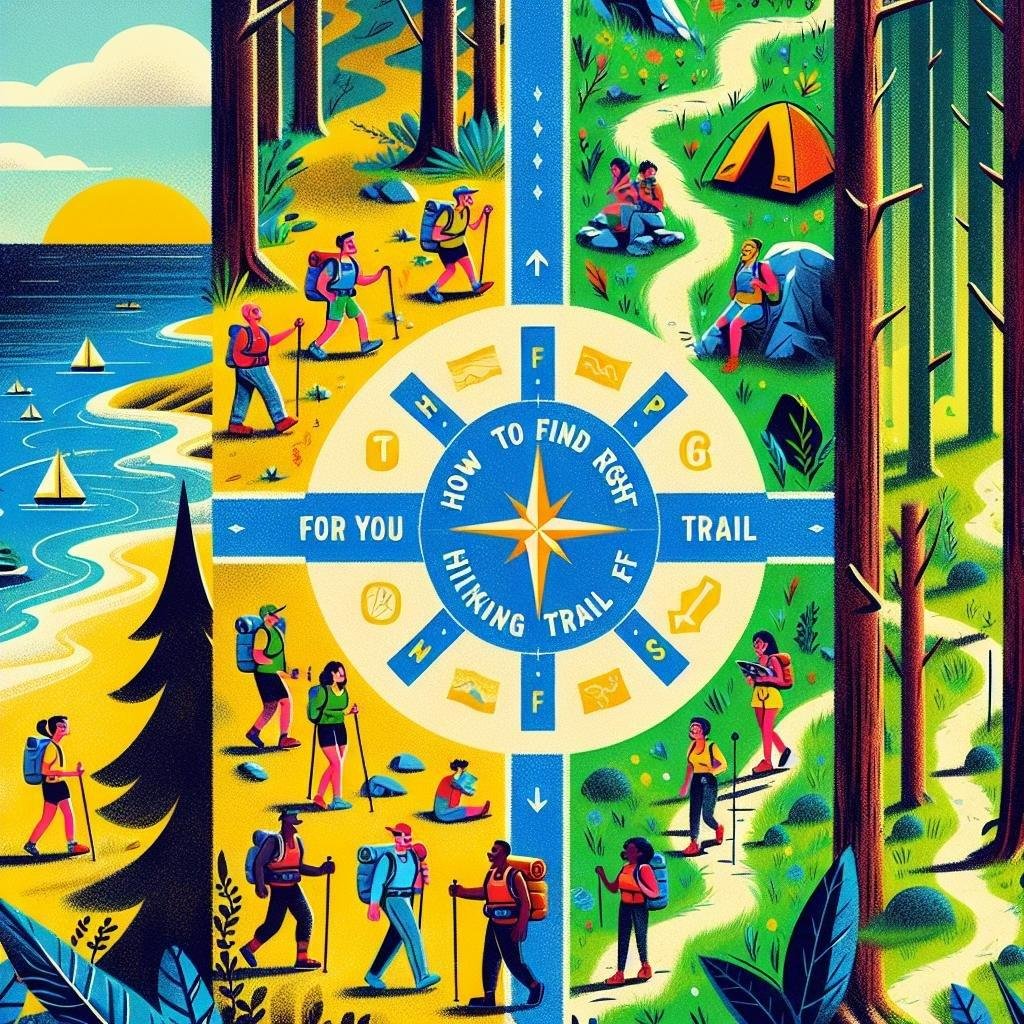In a world where adventure waits just beyond the horizon, finding the right hiking trail is akin to discovering a secret portal to nature’s wonders. Whether you’re a seasoned trekker or a budding explorer, choosing the perfect path can elevate your hiking experience from a simple stroll to a journey of finding. The ideal trail not only matches your fitness level and interests but also stirs the soul and invigorates the senses. In this article,we’ll embark on a quest to unravel the art of selecting a hiking trail that resonates with your spirit,guiding you through the myriad of landscapes and experiences that lie in wait. So lace up your boots, and let’s set off on this figurative hike to find the trail that calls your name.
Understanding Your Fitness Level and Experience
Assessing your fitness level and trail experience is crucial in selecting the perfect hiking trail. Start by considering how frequently enough you engage in physical activities. Are you someone who exercises daily, a weekend warrior, or is physical exertion a rare occurrence for you? If you’re a beginner, opt for trails that are marked easy, with flatter terrains and shorter distances. More advanced trails with steeper inclines and diverse terrain are better suited for experienced hikers who are accustomed to longer, more challenging treks. Be honest about your stamina and physical limits to ensure an enjoyable and safe hiking experience.
Additionally, reflect on your previous hiking experiences. Ask yourself the following questions:
- How much time did I spend on my last hiking trip?
- What was the trail difficulty and how comfortable was I with it?
- Did I encounter challenges such as steep climbs or river crossings, and how did I handle them?
Answering these questions will provide insight into your hiking comfort level, aiding you in choosing trails that match your skill set. Using a simple table,you can track and evaluate your fitness and hiking experience,making it easier to select suitable trails in the future.
| Trail Difficulty | Fitness level | Recommended Distance |
|---|---|---|
| Easy | Beginner | 2-5 miles |
| Moderate | Intermediate | 5-10 miles |
| Hard | Advanced | 10+ miles |
Exploring Trail Features and Scenery
- When seeking the ideal hiking trail, one of the most significant aspects to consider is the diverse features and breathtaking scenery different trails offer. Groves of towering evergreens, sunlit clearings adorned with wildflowers, and dramatic views from rocky outcrops all contribute to the allure of a particular path. Your preference might lean towards tranquil forest paths or perhaps stretches along sparkling, panoramic coastlines.Each trail has its unique charm and set of elements waiting to be discovered, from hidden waterfalls that tumble into serene pools to rugged ridgelines promising expansive views of the horizon.
- Before embarking on your hiking adventure, assessing available trail features can be invaluable. Consider whether your journey will entail crossing playful bubbling streams, wandering through lush, verdant valleys, or perhaps navigating steep, thrilling ascents. These characteristics can significantly influence not only your physical hiking experience but also the rewarding perspective and sense of accomplishment at the journey’s end. Don’t forget to research seasonal changes as well,which might transform a well-trodden summer path into a winter wonderland or a vibrant autumnal display.
| Trail Feature | Experience |
|---|---|
| Waterfalls | Calming, Photogenic |
| Rocky Outcrops | Adventurous, challenging |
| coastal Trails | Refreshing, Scenic |

Considering Seasonal Conditions and Weather
When selecting a hiking trail, it’s essential to take into account the seasonal conditions and weather patterns specific to your region. Understanding the variations in climate throughout the year will help you pick a trail that matches your personal preferences and safety level. As an example,a trail that is ideal for a spring stroll might transform into a treacherous ice path in the winter. Always check for trail conditions reports or updates from local hiking groups and park services to stay informed about potential hazards, like fallen trees or floods, which can appear after notably heavy rains or storms.
To aid your decision, consider the following factors that vary with the seasons:
- Temperature Changes: Some trails are more enjoyable in cooler weather, while others might be suitablе for summer hikes.
- Wildlife Behavior: Certain seasons might have increased wildlife activity which could be appealing or off-putting.
- Trail popularity: Seasons can influence how crowded a trail might be, offering more solitude in less busy months.
| Month | Weather Element | Recommended Trail Type |
|---|---|---|
| Spring | Rainy | Woodland Trails with Shelter |
| Summer | Hot & Dry | Shaded Forest Paths |
| Fall | Cool & Breezy | mountainous and Scenic Trails |
| Winter | Snowy | Groomed and Packed Snow Trails |

Utilizing Apps and Guides for Trail Discovery
embracing the beauty of nature while keeping the journey spontaneous is at the heart of every hiking enthusiast’s adventure. To ensure your hike aligns perfectly with your preferences and skill level, leveraging technology through apps and guides becomes essential. These tools are more than just modern conveniences—they’re gateways to hidden trails and breathtaking vistas. Numerous apps offer customized trail recommendations based on detailed user inputs like preferred difficulty level, distance, and scenic interests. Notably, platforms such as AllTrails, Komoot, and TrailLink provide complete maps, user reviews, and the ability to download trails for offline navigation. These tools can transform a simple hike into a well-planned expedition tailored precisely to your dreams and desires.
Integrating digital tools into your outdoor explorations opens a world of possibilities, making hiking both accessible and enjoyable for all. Guides and apps aren’t one-size-fits-all; they offer a plethora of features to suit any hiker’s needs. Consider the following benefits of popular trail discovery apps:
- AllTrails: Offers over 100,000 curated trails with community-generated reviews and photos.
- Komoot: Provides turn-by-turn voice navigation and highlights points of interest along your route.
- TrailLink: Features an extensive database focused on rail-trails, perfect for history enthusiasts wishing to explore repurposed train tracks.
| App Name | Unique Feature | Best For |
|---|---|---|
| AllTrails | Highly detailed maps | Exploration |
| Komoot | Offline capabilities | Remote hiking |
| TrailLink | Rail-trail focus | past trails |
Q&A
Q&A: Finding the Perfect Hiking Trail for Your Needs
Q1: Why is choosing the right hiking trail significant?
A1: Selecting the right hiking trail is crucial for maximizing your enjoyment and ensuring safety. A trail that suits your skill level, interests, and fitness can result in an invigorating and rewarding outdoor experience. Conversely, a trail that’s too challenging or doesn’t align with your interests might led to frustration or even injury.
Q2: What are the key factors to consider when choosing a hiking trail?
A2: When choosing a trail, consider your experience level, physical fitness, and the amount of time you have.Also, think about scenery preferences, such as forests, mountains, or lakes. Determine whether you prefer solitude or popular paths bustling with fellow trekkers. Weather and season should also influence your decision, as some trails aren’t accessible year-round.
Q3: How can beginners find trails suited to their skills?
A3: Beginners should start with shorter,well-marked trails with gentle elevations. Trail difficulty ratings and online resources like AllTrails or local parks websites often provide helpful information. It’s wise to read reviews from fellow hikers to gain insights into what the trail might truly be like.
Q4: What resources can definitely help in finding the right hiking trail?
A4: There are numerous resources at your disposal. Online platforms like AllTrails, hiking Project, and TrailLink offer detailed information, including maps and user reviews. Local hiking clubs and park ranger offices are excellent sources for personalized recommendations. guidebooks and hiking apps can also enhance your search.
Q5: How important is it to check the weather before setting out on a hike, and why?
A5: Checking the weather is vital before any hike.It determines what gear you’ll need and ensures you’re prepared for unexpected conditions. Sudden weather changes can transform a serene trail into a hazardous one, making this a crucial step for your safety and comfort.
Q6: Are there trails recommended for those looking for a more challenging hiking experience?
A6: For experienced hikers seeking a challenge, trails with longer distances, significant elevation changes, or rugged terrain might be ideal. Research trails with higher difficulty ratings and seek out those known for backcountry experiences or unique physical challenges. Always ensure you’re well-prepared with appropriate gear and information before embarking on these more demanding adventures.
Q7: How can hikers help preserve the trails they love?
A7: Trail preservation is a shared responsibility. Hikers can help by following the Leave No trace principles: pack out all trash, stay on designated paths, respect wildlife, and avoid picking plants. Volunteering for trail maintenance events and supporting local conservation efforts also contribute significantly to preserving these natural spaces for future generations.
Final Thoughts
As you lace up your boots and ready your backpack, remember that the perfect trail is out there, waiting with open arms and a path that whispers adventures fit for your feet alone. Whether you seek the gentle embrace of a serene forest or the invigorating challenge of a rugged ascent, let the trail you choose become a canvas for your story, painted with each step into a tapestry of discovery. With careful consideration and the tips we’ve shared, may your quest lead you to a trail that resonates with your spirit and nurtures your love for the wild. Happy hiking, fellow wanderer, until the next dawn calls you forth to explore the beauty of the unbeaten path.

